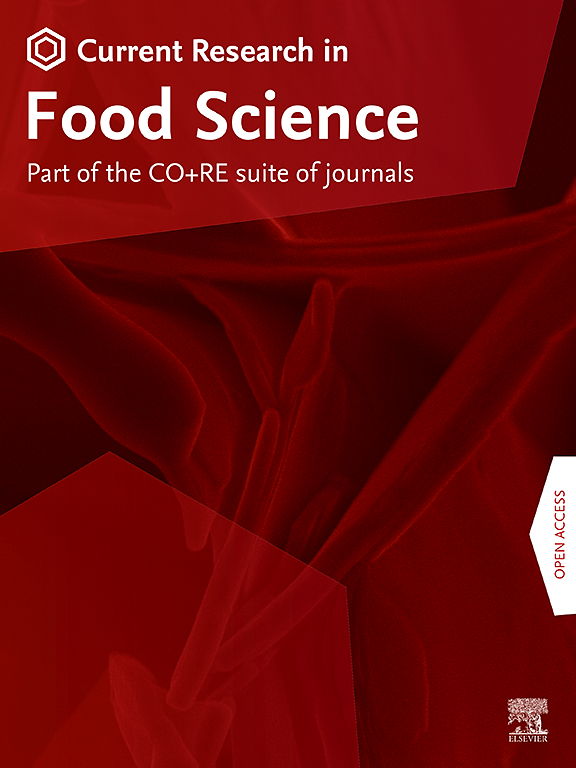Profiles of aroma volatile components in textured vegetable proteins using headspace solid phase microextraction-gas chromatography-mass spectrometry
IF 7
2区 农林科学
Q1 FOOD SCIENCE & TECHNOLOGY
引用次数: 0
Abstract
Textured vegetable protein (TVP) is a significant alternative to meat, with its primary raw materials being soybeans, peas, rice, and wheat proteins. While advancements in technology have successfully replicated the unique texture of meat in plant-based proteins, research on the aroma profiles of these key raw materials remains limited. The subtle differences in aroma between meat and meat substitutes are yet to be fully addressed. In this study, we employed headspace solid-phase microextraction (HS-SPME) combined with gas chromatography-mass spectrometry (GC-MS), a specialized technique for the analysis of volatile aromatic compounds, to examine the volatile profiles of soybean, pea, rice, and wheat proteins. The identified volatile compounds included alcohols, aldehydes, carboxylic acids, ethers, furans, indoles, ketones, phenols, pyrans, and sulfur compounds. Based on prior research, eight compounds (hexanal, nonanal, 2-nonenal, 3-methylbutanal, benzaldehyde, 1-octen-3-ol, 3-octen-2-one, and 2-pentylfuran) were classified as off-flavors. Hexanal, a key marker, was found in the following order: rice showed the highest levels, followed by soybeans, peas, and wheat. Other major volatile components exhibited distinct ratios across the samples. These findings could assist in refining the next generation of TVPs and minimizing aroma heterogeneity.

顶空固相微萃取-气相色谱-质谱法分析植物蛋白的香气挥发性成分
纹理植物蛋白(TVP)是肉类的重要替代品,其主要原料是大豆,豌豆,大米和小麦蛋白。虽然技术的进步已经成功地在植物性蛋白质中复制了肉类的独特质地,但对这些关键原料的香气特征的研究仍然有限。肉类和肉类替代品之间香气的细微差别尚未得到充分解决。在这项研究中,我们采用顶空固相微萃取(HS-SPME)结合气相色谱-质谱(GC-MS),一种专门用于分析挥发性芳香族化合物的技术,来研究大豆,豌豆,大米和小麦蛋白质的挥发性特征。鉴定出的挥发性化合物包括醇类、醛类、羧酸类、醚类、呋喃类、吲哚类、酮类、酚类、吡喃类和硫化合物。基于先前的研究,八种化合物(己醛、壬醛、2-壬烯醛、3-甲基丁醛、苯甲醛、1-辛烯-3-醇、3-辛烯-2- 1和2-戊基呋喃)被归类为脱味剂。己醛是一种关键的标记物,其发现的顺序如下:水稻的含量最高,其次是大豆、豌豆和小麦。其他主要挥发性成分在样品中表现出不同的比例。这些发现有助于改进下一代tpv,并最大限度地减少香气异质性。
本文章由计算机程序翻译,如有差异,请以英文原文为准。
求助全文
约1分钟内获得全文
求助全文
来源期刊

Current Research in Food Science
Agricultural and Biological Sciences-Food Science
CiteScore
7.40
自引率
3.20%
发文量
232
审稿时长
84 days
期刊介绍:
Current Research in Food Science is an international peer-reviewed journal dedicated to advancing the breadth of knowledge in the field of food science. It serves as a platform for publishing original research articles and short communications that encompass a wide array of topics, including food chemistry, physics, microbiology, nutrition, nutraceuticals, process and package engineering, materials science, food sustainability, and food security. By covering these diverse areas, the journal aims to provide a comprehensive source of the latest scientific findings and technological advancements that are shaping the future of the food industry. The journal's scope is designed to address the multidisciplinary nature of food science, reflecting its commitment to promoting innovation and ensuring the safety and quality of the food supply.
 求助内容:
求助内容: 应助结果提醒方式:
应助结果提醒方式:


